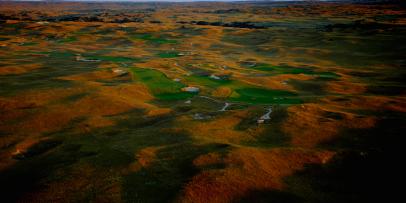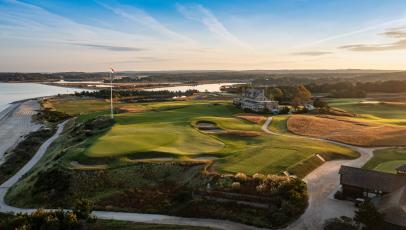Best in State
The best golf courses in Nebraska
The vast Sand Hills of north central Nebraska, where cattle outnumber people, comprise one of golf's most distinctive landscapes. Not unlike the links of Scotland and Ireland or the Sand Belt of Melbourne, their unique topography, soils and climate elevate nearly every course they touch. Seven of the top ten courses in Nebraska are in or touch parts of the Sand Hills, including the region's original design, Sand Hills Golf Club, ranked 8th on America's 100 Greatest Courses. That makes the Best in State debut of Landmand Golf Club, a 2022 design located over 200 miles away in northeastern farmland, even more impressive.
Below you'll find our 2023-'24 ranking of the Best Golf Courses in Nebraska.
We urge you to click through to each individual course page for bonus photography, drone footage and reviews from our course panelists. Plus, you can now leave your own ratings on the courses you’ve played … to make your case why your favorite should be ranked higher.



From Golf Digest Architecture Editor Derek Duncan:
Actor Nick Cage once ate a live cockroach for a film he was shooting. Later, when asked why—he could have eaten a pretend insect—he responded, “Anything less wouldn’t be real.” The conceit is that at times the only way to fulfill the potential of a given situation—a movie scene, a piece of art, a military offensive—is to push as far and aggressively as possible.
This principle applies to Landmand, a new design in northeastern Nebraska about 10 miles from Sioux City, Iowa. The course sits on a vast, elevated section of loess formations with eroded furrows and valleys. It winds across the bluffs and between valleys, and from the tops of the ridges horizon views of 20 miles or more are possible, filling the landscape with a feeling of unlimited proportion.
Given the setting, it’s impossible to discern the scale of the features in the near and middle distance, and the only way for architects Rob Collins and Tad King to make the golf look like it fit against the endless backdrops was to construct fairways 80 to 100 yards wide and greens that are, cumulatively and in some cases individually, the largest in the United States.
Explore our complete review here—including bonus photography and ratings from our expert panelists.




Dismal River, named for the eponymous body of water that flows through the rural Nebraska site, was created in the early 2000s as a slightly more upscale alternative to Sand Hills, at least amenity-wise. Located just a few miles from its inspiration, a course perennially ranked among the top ten on America's 100 Greatest Courses, Dismal River struggled to live up to its lofty goals and has changed ownership and operators several times. The White Course (a second course, the Red, was added in 2013) rolls across landforms similar to Sand Hills but are often more extreme and abrupt. When Jack Nicklaus was guiding his team through construction, he never went to examine what made the neighbor course so admired, and parts of the White lack the grace and naturalness of Sand Hills. The ground could have benefitted from a little more cutting and shaping, and in fact work was later done to soften and modify several holes. That's not to say there aren't stretches of great golf and powerfully emontional moments looking across the endless horisons of heaving grass dunes. The par-5 fourth plowing through a low valley adjacent to a broad sand blow out stands apart, as does the dogleg left seventh that climbs toward a natural greensite. Big hitters can try to drive the blind green over the top of a dune at the par-4 eighth, and the 11th, 14th and 15th all have turbulent greens partially hidden by bunkers and sand hill brows.

From Golf Digest Architecture Editor emeritus Ron Whitten:
Dan Proctor and Dave Axland have been quasi-legends in the business of golf course construction for over 30 years now, individually and collectively. They've worked on many of Coore & Crenshaw’s prominent designs, including Sand Hills (Nebraska's premier layout, in the center of the state's vast sand hills) and Cabot Cliffs (Canada's premier layout these days). They even rated cameo appearances in Geoff Shackleford’s 1998 novel, The Good Doctor Returns. And they were also a talented course design team in their spare time, routing and building quality low-budget courses in the Coore & Crenshaw style.
Their most prominent collaboration is Wild Horse in central Nebraska, a public “little brother” to Sand Hills, in slightly softer but still authentic sand hills, closer to civilization. Like at Sand Hills, Wild Horse is lay-of-the-land architecture routed without benefit of topographic maps, with natural-looking bunkers, native grass roughs and pitch-and-run shots galore. Total earth moved: 5,000 cubic yards. Total construction costs: a little less than $1 million.
In my opinion, it's the best low-cost golf course in the nation. I admit I'm showing provincialism here. I was born and raised in Nebraska, and I'm partial to her natural treasures, of which Wild Horse is certainly one. There are many other fine public courses in the Midwest that are even less expensive to play than this one, but none, I will argue, will give you quite as genuine a prairie links experience as Wild Horse.
Explore our complete review here—including bonus photography and ratings from our expert panelists.

Not as pure a Nebraska sandhills experience as sister Dunes Course, the Pines Course has just 11 holes playing in the tumbling prairie topography. It repeatedly touches the edge of a deep canyon formed by the Snake River. Those seven holes (6 & 7, 10 & 11 and 16 through 18) are lined with tall pines and cedars and bring to mind a collection of holes in the Colorado Rockies. For pure golfing variety, Prairie Club rivals even Bandon Dunes.

• • •
Explore Golf Digest's recently relaunched Places to Play community, where you can add star ratings and reviews for all the courses you play. We've collected tens of thousands of reviews from our course-ranking panelists to deliver a premium experience, which includes experts' opinions, bonus course photography and videos, plus much more. Check it out here!


